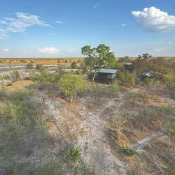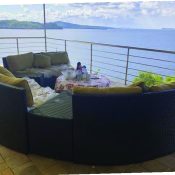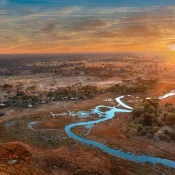
Kariba: A grand tourism spectacle to savour
When I visited Kariba, a molten lava-coloured dawn was prelude to a breathless morning as Lake Kariba’s silhouette-tinged water mirrored fleeting shapes of boats, riverine vegetation, a multifarious array of architecture, saddle-billed storks and kingfishers which shattered each illusion with an acrobatic splash.
At every plunge, the water turned silver and gold, rippling to the shores, with a wash and swash on sump of sand between a steep bank and gurgling shallows.
A huge Nile crocodile stealthily marshalled the shoreline, attacking its prey with sporadic sluggishness, driven by life’s ancient rhythm to survive.
Having arrived there the night before, I came to realise why Nyanyana Lodge remains a place where those who wish to enjoy Kariba should visit.
The night before we were snorted to sleep by mooing hippos and serenaded to dawn by the fish eagle. From the veranda of the lodge, I tottered barefoot over pebbles to slosh the shivery water but, alas, a huge monster of a crocodile plunged into the water, obviously disturbed by my uninvited presence.
My eyes scanned the shoreline and a chattering crowd of ox peckers alerted me to a bloat of sunbathing hippos.
I remembered exactly how ox peckers are somewhat two-faced; when they warn their hosts of intruders, they also betray their position.
While I was still pondering about the ox peckers’ two contrasting positions, a huge hippo yawned, exposing huge teeth and a reddish internal. Almost at the same time, a tro0p of monkeys squabbled noisily from a tree, swinging nonchalantly from one branch to another. Their proclivity for agility as amazing as ever.
On the water, three crocodiles stealthily moved northwards, like dead pieces of logs, only to be betrayed by their sentry-post eyes that remained above the surface.
The National Parks and Wildlife Management Authority owns the lodges, which lie on the southernmost bank of Kariba adjacent to the Crocodile Farm.
The lodges are self-catering under a family type scenario and are tastefully decorated with mopane wood and matching ceilings.
The outside is painted green, the trademark of national parks, the vanguard of Zimbabwe’s wild flora and fauna.
Booking and reservations are done centrally in Harare.
In Kariba, water is worthy benevolent mistress, kissing the sky with all the love of nature and providing the much-needed life, comfort and business.
Where the land meets the water, in swash and backwash, silky white coves hem in the azure bays, overlooked by a chain of wild jungle-draped rolling hillocks and mountains.
It is from the peaks that wild animals streak to the lake-shore to quench their thirst, bath and feed on the lush green vegetation. From the shaggy water buck to the nimble-footed duiker, the spindle-legged impala to the boisterous jumbo and sluggish hippo, the lake is a source of life.
From leafy suburbs and sprouting settlements dotted around the shoreline to the rest of Zimbabwe and beyond, Kariba has become a tourist resort of repute and a source of fish. It is an attraction of repute.
Where the jungle is still alive: Matusadonha
A well-fed monster, a crocodile, snaps to life startled from its nap. It stampedes through the crunchy undergrowth, crashing into the water, becoming invisible except for a pair of sentry-post eyes that peek menacingly above the surface to monitor outside movement.
As if nothing has happened, a huge bull elephant grazes on the shoreline vegetation, its body half-submerged in water, chewing and munching.
The shoreline vegetation is juxtaposed with a cloak of virgin forest, where dappled bushbucks move in fleet but silently through the thicket.
Shaggy waterbuck, buffalo and other grazers invade the shoreline for a sip of the life-saving water, forever stalked by predators.
Central to this is Matusadonha National Park, situated on the shores of Lake Kariba but was proclaimed a non-hunting area on November 7, 1958 before the dam was built.
It became a game reserve in 1963, and in 1975 it turned into a national park in terms of the Parks and Wildlife Act.
The park comprises some 1 400 square kilometres of diverse flora and fauna.
The grass found on the shoreline is Panicum ripens and is a rejuvenating grass, needing only fluctuating lake levels to replenish its nutrients.
With this ready food source, buffalo, water buck, zebra and even impala have thrived together with predators.
Matusadonha is an Intensive Protection Zone (IPZ) and home to several relocated rhinoceros. The southern boundary of the park is the Omay communal lands and the northern boundary is the lakeshore.
The eastern side of Sanyati Gorge and the middle of the Ume River provide the east and west boundaries respectively.
Matusadonha has three distinct ecological areas. First is the lake and shoreline grassland; second the Zambezi Valley floor, a mass of thick jesse and mopane woodland and third the escarpment area of Julbernadia and Brachystegia woodlands. The jesse/mopani area is sparsely grassed, but provides habitat for browsers, most notably the black rhino.
Elephants can be seen all over the park, seeking the shade of the jesse in the heat of the day.
The Zambezi Escarpment rises some 700 metres above the valley floor and is extremely rugged.
Tiger fishing
At 6am sharp, a gunshot and a magenta flare fired high up against the sunrise silhouette, sends engine-powered boats puffing off to the various corners of Lake Kariba to catch the big one. Then I knew it was tiger time!
Tiger fish is known for its sheer speed and aggression, pound for pound and is ranked as the world’s most powerful fresh water species that grows up to 45kg.
On catching it, the tiger fish’s initial run is fast and strong and is usually followed by spectacular leaps of one or two metres into the air to shake off the hook, and then a series of deep, determined runs, which chew every ounce of strength from this game fish.
Finally, after about 10 minutes of fighting, the tiger fish is pulled, belly-up, to the side of the boat, where it tries to make one or two last breaks to freedom — like a man trying to break from chains — but is gaffed and brought onto the boat. The very tackle many fishermen use for tiger is in itself, a telling tribute to the fighting qualities of Africa’s most elusive, ferocious and speedy game fish. In Zimbabwe, the biggest catch record stands at 15,5kg.
The tiger tournament is always slated for October every year on the two darkest nights, because traditionally, the tiger does not feed at night when it is dark, hence it becomes susceptible to anglers the next daybreak.
Tiger fish is known throughout the world for its ferocity and fighting spirit, traits that make it one of the most sought-after game fish in the world.
The sporting quality of tiger fish can only be truly appreciated if fairly light tackle — with one to 4kg line — is used.
All Categories
Recent Posts
Kazuma Safari Camp –
Kariba’s Kumabirira Lodge Is The Perfect Hideaway
Contact Us
+263 789 532 918




